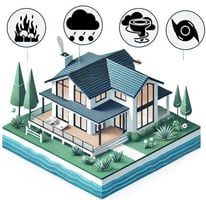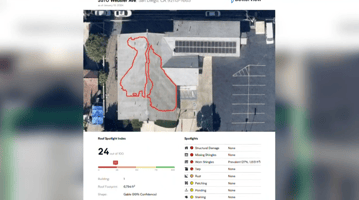In an era where climate risks are increasing and homeowners face rising insurance challenges,...
Improving Utility Reliability with Predictive AI Vegetation Management Tools
 As wildfires become more frequent and devastating, utility companies are under increasing pressure to mitigate risks associated with vegetation near power infrastructure. Managing vegetation is critical since nearly 25% of all power outages in the U.S. are caused by vegetation contact with power lines. For some large utilities, vegetation management represents the single largest operational expense, often exceeding $100 million annually according to Electrical Contractor Magazine. The high costs arise from manual inspections, workforce shortages, and the need for regular trimming along extensive distribution networks that span over 5.7 million miles across the country.
As wildfires become more frequent and devastating, utility companies are under increasing pressure to mitigate risks associated with vegetation near power infrastructure. Managing vegetation is critical since nearly 25% of all power outages in the U.S. are caused by vegetation contact with power lines. For some large utilities, vegetation management represents the single largest operational expense, often exceeding $100 million annually according to Electrical Contractor Magazine. The high costs arise from manual inspections, workforce shortages, and the need for regular trimming along extensive distribution networks that span over 5.7 million miles across the country.
Utility-related wildfires, like California’s 2018 Camp Fire, have underscored the urgency of adopting advanced technologies. Predictive vegetation management tools powered by generative artificial intelligence (Gen AI) offer scalable solutions by automating risk identification, forecasting vegetation growth, and prioritizing maintenance efforts. Companies that have adopted predictive models report cost savings of 20-30% without sacrificing reliability. These tools not only reduce operational costs but also help utilities meet regulatory compliance requirements and improve public safety by preventing potential hazards.
Growing Threat of Utility-Linked Wildfires
Recent wildfires have underscored the critical need for proactive vegetation management. In California, utility-related fires, such as the 2018 Camp Fire, caused by faulty power lines, led to tragic loss of life, destruction of entire towns, and billions of dollars in damages. Similar incidents have occurred globally, where vegetation encroaching on power lines has ignited fires during extreme weather conditions, leading to blackouts and public safety emergencies. With climate change contributing to longer fire seasons, utilities must implement forward-looking strategies to prevent such disasters.
Predictive AI-Powered Solutions to Identify and Evaluate Risks
Predictive vegetation management tools powered by predictive AI are transforming the way utilities monitor and maintain vegetation near transmission and distribution lines. Ortho imagery collected from satellites, drones, and helicopters provides detailed visual data of vegetation in proximity to power infrastructure. By integrating this imagery with computer vision and AI models, utilities can accurately identify risks—such as overgrown trees and dry brush—that pose pontential fire hazards.
Predictive AI models, like those developed by Tera Analytics, automatically analyze thousands of images of network infrastructure and generate comprehensive risk assessments. These models can detect patterns that indicate where vegetation is encroaching on power lines, evaluate current infrastucture condition, and prioritize maintenance efforts based on areas of highest risk. This predictive approach empowers utilities to proactively manage vegetation, reducing the chance of electrical equipment sparking wildfires and ensuring compliance with safety regulations.
Leveraging ChatGPT and Other Gen AI Tools
Utilities and analysts are increasingly turning to tools like ChatGPT to enhance decision-making. By combining aerial imagery including olbique images with custom trained generative AI, utilities can streamline how they evaluate and act on risk assessments. For example, a GPT can help field teams and planners interpret and quantify imagery, provide real-time recommendations, and generate maintenance priorities based on AI-generated insights.
ChatGPT’s ability to summarize complex unstructured datasets like imagery and offer actionable insights fosters better communication across departments, ensuring that vegetation management tasks are efficiently prioritized. Additionally, it supports reporting and regulatory compliance by generating detailed reports on vegetation risks, helping utilities demonstrate that they are taking proactive steps to mitigate potential hazards.
Example Custom Pole Risk Scoring GPT
Benefits of Predictive Vegetation Management
Integrating predictive AI tools into utility operations can dramatically reduce the risk of fire-related incidents, outages, and equipment failures. Proactively identifying and mitigating vegetation risks offers several key benefits:
- Fire Prevention: Early detection of high-risk vegetation zones reduces the likelihood of power lines sparking wildfires.
- Improved Reliability: Preventing outages caused by vegetation contact enhances service reliability and minimizes disruptions for customers.
- Regulatory Compliance: AI-powered assessments help utilities meet local and federal vegetation clearance standards, avoiding penalties and legal liabilities.
- Public Safety: Proactively managing vegetation risks protects lives and property, especially in wildfire-prone areas.
Future-Proof Approach to Vegetation Management
As climate change continues to drive more frequent and severe wildfires, utilities must adopt innovative strategies for effective vegetation management. AI-powered predictive tools provide a scalable and efficient way to monitor risks, mitigate hazards, and reduce operational costs. When integrated with predictive AI tools like ChatGPT, utilities can further enhance their ability to make informed decisions, prioritize tasks, and respond swiftly to emerging threats.
The convergence of aerial imagery and generative AI tools defines the future of vegetation management. These technologies allow utilities to move beyond reactive maintenance and embrace a proactive, predictive approach—ensuring safer, more reliable power networks and safeguarding communities from the growing threat of wildfires.
About the Author
.jpg?width=200&height=200&name=RC_Headshot%20(Phone).jpg) Rob Carroll is a seasoned expert with over 35 years of experience in geospatial technology, aerial imagery, and artificial intelligence. As the founder of Tera Analytics, he helps organizations in the utility, insurance, and government sectors transform aerial data into actionable insights. His leadership journey includes pivotal roles at industry leaders like EagleView (Pictometry), Nearmap, and Vexcel Data, where he drove innovation, product development, and go-to-market strategies.
Rob Carroll is a seasoned expert with over 35 years of experience in geospatial technology, aerial imagery, and artificial intelligence. As the founder of Tera Analytics, he helps organizations in the utility, insurance, and government sectors transform aerial data into actionable insights. His leadership journey includes pivotal roles at industry leaders like EagleView (Pictometry), Nearmap, and Vexcel Data, where he drove innovation, product development, and go-to-market strategies.
Committed to lifelong learning, Rob holds certifications in Python programming from the University of Michigan, Satellite Navigation from Stanford University, Spatial Computing from the University of Minnesota, and Business Innovation from the University of Maryland. These academic achievements reflect his ability to stay at the forefront of technological and business trends.
Rob is also a recognized thought leader in the geospatial and remote sensing community, having presented at global conferences and published works on topics such as aerial imagery applications, property valuation techniques, hydrographic surveys, and automated change detection. His insights have been featured at key industry events across North America, Europe, and Asia, where he has discussed the use of cloud-based geospatial platforms, oblique imagery, and the role of advanced technologies in disaster response and government operations.
Known for blending technical expertise with strategic vision, Rob specializes in GIS, remote sensing, artificial intelligence, and product management. Through Tera Analytics, he continues to deliver innovative, scalable solutions that empower organizations to achieve measurable, long-term success.





